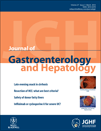Grade of deceased donor liver macrovesicular steatosis impacts graft and recipient outcomes more than the Donor Risk Index
Abstract
Background and Aim: Donor liver steatosis can impact on liver allograft outcomes. The aim of the present study was to comprehensively report on the impact of type and grade of donor steatosis, as well as donor and recipient factors, including the reported Donor Risk Index (DRI), on liver allograft outcomes.
Methods: A review of unit data for all adult liver transplant procedures from 2001 to 2007, as well as donor offers. Donor liver biopsies were regraded for steatosis by an experienced histopathologist.
Results: Steatosis was detected in 184/255 (72%) of biopsies, of which 114 (62%) had microvesicular steatosis (MiS; 68 mild, 22 moderate, 24 severe) and 70 (38%) macrovesicular steatosis (MaS; 59 mild, 7 moderate, 4 severe). The majority (66/70, 94%) of biopsies with MaS also contained MiS. Allograft steatosis was associated with increasing donor body mass index (P = 0.000), plus donor male sex (P < 0.05). Primary non function (P = 0.002), early renal failure (P = 0.040), and requirement for retransplantation (P = 0.012) were associated only with severe MaS. Early biliary complications were associated with moderate MaS (P = 0.039). Only severe MaS was significantly associated with inferior allograft survival at 3 months (relative risk = 12.09 [8.75–19.05], P = 0.000) and 1 year (P = 0.000).
Conclusions: MiS is a common finding and frequently coexists with MaS on liver allograft biopsy, while isolated MaS is uncommon. Only the presence of moderate to severe MaS is associated with inferior early allograft outcomes. The impact of severe MaS on allograft survival appears greater than other donor factors, including the calculated DRI.




